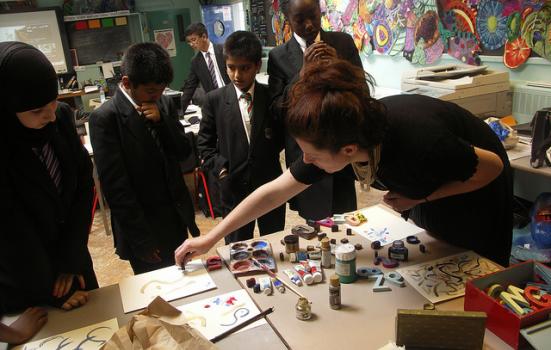Just a third of art and design teachers say their subjects are highly valued by senior management – fewer in state schools than independent schools.

HSBC UK Press Office (CC BY-NC-ND 2.0)
Less than a third of teachers say pupils are encouraged to take art-based subjects, while more able students are actively discouraged “even if they show a particular interest or talent for the subject”, a new survey has revealed. The National Society for Education in Art and Design (NSEAD) says the findings are “as unsurprising as they are unwelcome”, but hopes that they will provide a critical benchmark for its advocacy work. The survey report draws five main conclusions, “all of which reflect the negative impact of policy changes on our subject and on our community”: performance measures are eroding provision at Key Stage 3 and 4 (pupils ages 11-16); fewer specialist art and design teachers are being trained and there is a paucity of subject specific professional development; arts learning opportunities for pupils both in school and within the cultural sector have diminished; and arts subjects are considered to lack value, especially in the state school sector.
While little over a third of NSEAD members who responded to the survey said art, craft and design are “highly valued” by senior managers and/or governors, 57% said they are “valued”. Almost two thirds report that these subjects are “highly visible” in their schools, although this is higher (86%) in independent schools. Only half agreed that their school supports exam students engaging with original artworks. One respondent said: “The main issue is parents seeing it as lower down the pecking order due to news reports and mixed messages given by the Government.”
Policy changes that have led to the erosion of the arts in schools include the introduction of the English Baccalaureate, which is considered to discourage higher ability students from taking practical subjects; discount codes, which limit the number of arts subjects pupils can take at GCSE; and Progress 8 which places double weighting on maths and English, leading to schools taking lesson time away from arts subjects. More than a third of secondary schools have reduced the time allocated to the arts over the last three years, while budget cuts have led to schools having to charge pupils for materials. One respondent said: “We no longer deliver lessons that require expensive materials, for example, textiles at KS3.”
General Secretary Lesley Butterworth said: “The National Society for Education in Art and Design will rigorously debate and seek to challenge the implications of the survey as a key part of its strategic direction in support of the teachers and educators for whom it serves.” The report defines seven areas for future investigation including solutions to the negative impact these policy changes have had, ways to secure continuing professional development for art and design teachers, achieving a better understanding of the transferrable skills gained through these subjects, and tackling regional differences in pupils’ access to the arts.




